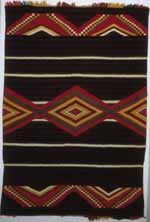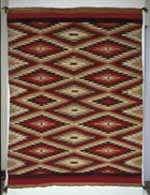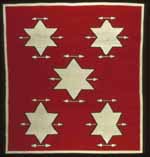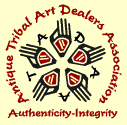|
Brilliant: Navajo
Germantown and Eyedazzler Textiles
Through January
2002
Exhibit
Explores Dramatic, Innovative Period in Navajo Weaving
Brilliant:
Navajo Germantown and Eyedazzler Textiles showcases pieces from an
innovative period in Navajo weaving traditions when weavers began to have
access to a wide range of colored yarns. Using the new palette, weavers
began to experiment with new designs.
"Navajo
textiles are brilliantly executed," says Ann Marshall, director of
collections, education and interpretation for the Heard Museum and curator
of the exhibit. "In each piece, you see an impressive level of mastery in
both design and technique.
"In some
pieces the quality of the weave carries forward the technical skill of the
earlier Classic period," Marshall notes. "In all, there is an exuberant
burst of color that has captured the eye of modern-day collectors."
Brilliant
draws from the collections of the Heard Museum and private collectors.
Several of the textiles displayed are drawn from the museum's original
collection, acquired by Maie Heard for use in her home and to be displayed
in the new museum she founded with her husband, Dwight. Other textiles in
the exhibit were collected by the Fred Harvey Company and given to the Heard
Museum in the 1970s. The textiles displayed are supplemented with
interpretive text by curator Ann Marshall and contemporary weaver Marilou
Schultz, Navajo. Schultz weaves in the Eyedazzler and Germantown
styles, and her comments provide an intriguing glimpse into the design
process and accomplishments of the weavers whose work is displayed.
The
Germantown & Eyedazzler Textile Traditions The Germantown and eyedazzler
periods developed between 1870 and 1910, and they were characterized by
vivid experimentation with color and design. Eyedazzler textiles are noted
for their dramatic designs and bright colors, designs that may include
optical illusions. Germantown is a generic term applied to textiles woven
with commercial yarns of the period. The term references the area in
Pennsylvania where much of the yarn was produced.
These textile
traditions arose out of the changes the Navajo experienced upon returning to
their homelands following imprisonment in Bosque Redondo in Southern New
Mexico from 1864 to 1868. During the Bosque Redondo era, Navajo weavers were
exposed to the Hispanic textile traditions of Northern New Mexico, which
included colors and designs very different from traditional Navajo designs.
Colors and shapes on commercial products brought West by the railroad also
served as inspiration for the weavers. This access to new colors, the
influence of Hispanic textile designs and market forces led weavers to
create new designs and develop textiles for uses in addition to utility.
Commercial
yarns were imported from Pennsylvania to supplement the shortage of sheep
wool, which came out of the warfare, forced marches and disease preceding
and during Bosque Redondo. The U.S. government continued importing
commercial yarn following the Navajo's return to their homelands. The wide
range of colors available made it possible for weavers to pictorially depict
images with a clarity and crispness not previously possible.
Following
Bosque Redondo, the Navajo had greater access to commercial products,
decreasing the reliance on hand-woven garments. However, the need for income
remained, and weavers could now explore a greater imaginative freedom.
|
|
 Navajo
Textile, 1880s
Navajo
Textile, 1880s
Germantown wool yarns
Collection of the Heard Museum

Navajo Textile, 1880s
Germantown wool yarn
Collection of the Heard Museum

Navajo
Pictorial Textile, c. 1890-1920
Germantown wool yarns
Collection of the Heard Museum
|




